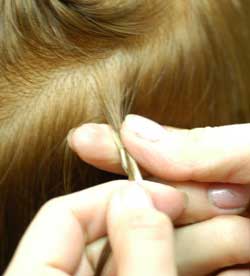Only humans have hair. All other animal species have fur, even if those strands grow on their heads. Therefore, since ancient times, humans have known how to beautify their hair. However, hair is not eternal. It falls out, either strand by strand or in large patches. This is also one of the “hidden pains” many modern gentlemen experience.
Hair Reflects Human Condition and Living Environment
 |
Professor JoAnn Manson |
First of all, we know that the visible part of hair is actually the hair strand, which is defined biologically as a “dead organ.” Yet, this is where valuable data is provided for various scientific fields, especially archaeology when determining the race and gender of mummies. Meanwhile, environmental sciences analyze many components contained in hair to identify toxins present in the individual’s living environment, including alcohol, nicotine, and other substances they may use.
On the other hand, hair is very sensitive to our states of fatigue, exhaustion, or traumatic psychological shocks. At that time, there will be a lot of buildup at the hair roots due to increased oil secretion. Interestingly, hair can also serve as a measure of an individual’s cardiovascular health. According to Professor JoAnn Manson of Harvard University (USA), men experiencing hair loss at the crown are 34% more likely to suffer from cardiovascular diseases compared to those who only lose hair at the temples.
Stay Calm When Experiencing Hair Loss
Hair loss affects about 20% of men aged 25 to 35, and by the age of 50, over 50% of men experience hair loss. This is indeed a concern for most men. Once they find themselves caught in this spiral, many gentlemen may feel confused, anxious, and perceive themselves as becoming “older” in the eyes of others, especially when facing women. This phenomenon significantly impacts the “appearance” of men from a sociological perspective. Consequently, it has become a focal area of research among hair specialists, aiming to continuously improve hair care products, medications, dyeing techniques, and ultimately discover the most effective treatments for baldness.
According to professional data, 90% of baldness cases arise from a dual cause: genetics and hormonal influences. Each hair strand carries a “secret” genetic code from the parents; if the parents experience hair loss or baldness, the child is likely to inherit this condition. Furthermore, if the individual has a dysfunction in male hormones, where testosterone is rapidly converted into dihydrotestosterone, this substance adversely affects hair, shortening the hair growth cycle and leading to premature destruction of the hair roots. Consequently, hair will fall out sooner. Additionally, according to experts in skin and hair diseases at the Sabouraud Center in Paris (France), hair can also fall out due to psychological causes such as stress, excessive smoking, and the effects of certain drugs used in chemotherapy, as well as antidepressants and anticoagulants. We cannot overlook the impact of poor nutrition in individuals with inadequate diets: lacking vitamins, zinc, and iron. Due to these various causes, our hair can become “damaged” and more “fragile.”
A reference number: if you are losing around 150 strands of hair each day, then be cautious. This is a pathological hair loss phenomenon, and worse, you may soon be facing baldness! Naturally, no one has the time and energy to count each fallen hair daily, but if you feel that your hair is suddenly falling out at least three times more than usual, pay closer attention.
In the Future, When “Baldness” Is Just a Memory…

(Image: SSTT)
In France alone, there are 10 million men suffering from baldness. To keep up with the latest achievements in the technical sciences of the 21st century, leading biotechnology sectors like cell cloning and stem cells are eagerly entering the field. At the University of British Columbia (Canada), Professor Kevin McElwee has taken hair root cells and “photocopied” them into multiple “copies,” then cultivated them in the laboratory and finally injected them back into the patient’s scalp. After some time, these “hair buds” will develop into a new layer of hair.
The first experiments using this method were conducted by Intercytex, a company in the UK, in 2005 with seven volunteers, resulting in five satisfied individuals. This June, they will conduct further clinical trials to confirm the final results. However, a significant limitation here is finding enough hair roots needed!
Understanding this situation, last October, Swiss experts experimented with producing “ready-made hair roots” from their stem cell resources. These “hair root products” will have the ability to develop according to the growth cycle of hair strands, resulting in “real and perfect hair.” This is undoubtedly a groundbreaking biological revolution aimed at helping balding areas regrow hair continuously.
However, while waiting for these new results to be widely applied, men must temporarily be satisfied with hair transplantation methods. Although somewhat traditional, over 60% of men have regained their confidence after seeing their hair still… green!
Beautifying Hair
 |
| (Image: hisandher) |
Beautifying means addressing aesthetics, “maintaining or renewing beauty.” It is indeed complicated when some individuals have a completely “green” head of hair but are still not satisfied. They desire a “chameleon” hair – sometimes red, sometimes yellow, sometimes shimmering in multiple colors! And science always caters to the whims of those who are keen on “changing their hair.”
Throughout history, we have known many methods of dyeing hair. While there are many, one of the top products in the West for 2006 that captured public attention was the “hair color matching machine,” also known as a colorimeter, the latest generation. This device allows customers to carefully view and compare color combinations to select their most preferred hair color.
As for dyeing gray hair, there have been numerous methods. Recently, scientists made a significant discovery regarding the phenomenon of “death by association” between pigment cells and an enzyme called TRP2. This enzyme primarily functions in the production of pigment, but when it disappears, the pigment cells cease to exist as well. Consequently, scientists have embarked on researching the “dyeing” of gray hair using biological methods. They are testing ways to create “decoy” molecules. These molecules will “disguise” themselves as TRP2 enzymes to operate, thereby “deceiving” pigment cells into thinking that the TRP2 enzyme is still present, preventing them from self-destructing. However, it will take a few more years to determine the results. Hair experts have assured us of this!
Why “Blond Hair”?
 |
| Canadian Anthropologist – Peter Frost (Photo: sauder.ubc) |
Men are attracted to blonde women. At least, that’s the case for Western men. This phenomenon dates back to the time when humans lived in caves. According to Japanese experts, the first blonde girl emerged about 11,000 years ago in Europe, at the end of the Ice Age. At that time, women were unable to hunt or gather food due to the extremely cold weather, leaving them completely dependent on men for sustenance. However, the number of men returning from hunting trips had significantly dwindled, resulting in a small population of strong men who survived.
Faced with this situation of “female abundance and male scarcity,” nature, in its harshness, generously provided men with an opportunity to choose more easily in a world filled with “brown-haired” individuals: everyone looked the same! This led to a genetic mutation in the MC1R gene, creating a few standout individuals who attracted the attention of men—these were the “blonde beauties.” According to Canadian anthropologist Peter Frost, the first “blonde fairies” immediately caught the eye of the opposite sex. The result was that the few remaining men were highly attracted and “rushed” towards these “golden-haired” women to… ensure the continuation of their lineage. Thus, blonde hair has persisted to this day.
According to Professor JoAnn Manson from Harvard University (USA), men who experience hair loss on the crown of their head are 34% more likely to develop cardiovascular diseases compared to those who only lose hair on the sides of their temples.
Does Hair Provide a Balance of Justice?
On average, hair grows about 1cm each month. Therefore, a 6cm strand of hair can convey “real stories” that its owner has experienced over the past six months. Finding a hair strand may not be difficult, but obtaining an intact hair strand with the root from victims who have died can sometimes be quite a challenge.
In such cases, experts have proposed an alternative solution: they will analyze a type of DNA called mtDNA (mitochondrial DNA) present in the mitochondria of normal hair strands. However, since mtDNA only provides a portion of an individual’s entire genetic code because it is inherited solely from the mother, according to molecular biologist Hélène Pfitzinger, who is also a forensic expert, “mtDNA does not help us accurately identify a perpetrator, but at least it allows us to potentially exclude a subject from the list of suspects.”
It is also important to note that we cannot shave our heads to eliminate all traces, as other hair samples like armpit or pubic hair can provide the same information as that collected from a single hair strand. Thus, hair, when defined in the most “legal” sense, is simply “the strands of hair that grow on the head.”
Nguyen Tuong




















































